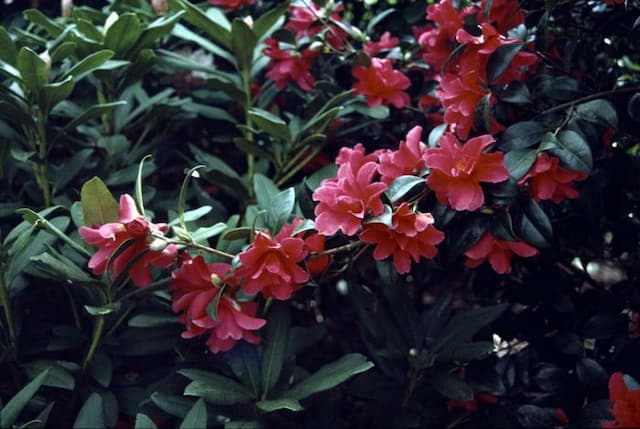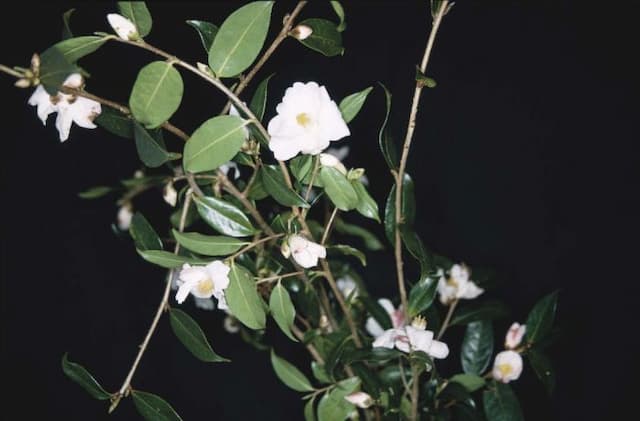Japanese Camellia Camellia japonica 'Alexander Hunter'

ABOUT
The Camellia japonica 'Alexander Hunter' is a cultivated variety of the camellia plant known for its ornamental value. This camellia showcases glossy, deep green leaves that provide a lush backdrop for its striking flowers. The blooms are large and typically deep red or pink, with a multitude of petals that create a full, peony-like appearance. These petals can have a velvety texture and are elegantly arranged in a dense, round shape that can be quite eye-catching. The blooms often feature a bright cluster of contrasting yellow stamens at their center, which adds to their visual appeal. The overall impression of the 'Alexander Hunter' variety is one of classic elegance, with a profusion of richly colored flowers that stand out against the dark, lustrous foliage.
About this plant
 Names
NamesFamily
Theaceae
Synonyms
Japanese Camellia, Camellia
Common names
Camellia japonica 'Alexander Hunter'.
 Toxicity
ToxicityTo humans
The Camellia, specifically the Camellia japonica 'Alexander Hunter', is not considered toxic to humans. Therefore, there are no symptoms of poisoning or toxic consequences associated with ingesting any part of this plant.
To pets
The Camellia is also not considered toxic to pets. Ingestion of this plant should not cause any symptoms of poisoning or toxic consequences in animals such as dogs or cats. However, individual pets may have different sensitivities, so it is always best to monitor your pet and consult with a veterinarian if any unusual symptoms occur after ingestion.
 Characteristics
CharacteristicsLife cycle
Perennials
Foliage type
Evergreen
Color of leaves
Green
Flower color
Pink
Height
6-10 feet [1.8-3 meters]
Spread
5-7 feet [1.5-2.1 meters]
Plant type
Shrub
Hardiness zones
7
Native area
Japan
Benefits
 General Benefits
General Benefits- Ornamental Value: Camellia japonica 'Alexander Hunter' features attractive, large flowers that add aesthetic appeal to gardens and landscapes.
- Long Blooming Season: It typically has a long blooming period from late winter through spring, providing color when many other plants are dormant.
- Evergreen Foliage: The plant maintains its glossy green leaves throughout the year, ensuring continuous greenery in the garden.
- Shade Tolerance: This variety of camellia is adaptable to low-light conditions, making it suitable for planting under taller trees or in shadier parts of the garden.
- Versatility: It can be used in various landscaping designs, including borders, foundations, and as a specimen plant.
- Privacy: When planted in a row or hedge, it can provide privacy screening due to its dense foliage.
- Drought Tolerance: Once established, Camellia japonica 'Alexander Hunter' can tolerate some dry spells, though it prefers consistently moist soils.
- Wildlife Attraction: The flowers can attract pollinators like bees, while the dense foliage can provide shelter for birds and other wildlife.
- Resilience: This plant is relatively hardy and can endure cold weather, though it prefers milder climates.
 Medical Properties
Medical PropertiesThis plant is not used for medical purposes.
 Air-purifying Qualities
Air-purifying QualitiesThis plant is not specifically known for air purifying qualities.
 Other Uses
Other Uses- Camellia japonica 'Alexander Hunter', commonly known as the Japanese Camellia, can be used as a natural dye for fabrics, providing a range of colors from pale greens to grays depending on the mordant used.
- The waxy leaves of the plant can be used in floral arrangements for glossy, green background foliage that complements colorful flowers.
- Petals of the Japanese Camellia can be pressed and used in crafts such as handmade paper or bookmark and card embellishments, adding a delicate, floral touch.
- Fallen camellia petals can create a visually intriguing, natural carpet under the plant, which can be encouraged in garden design for a romantic garden aesthetic.
- The seed oil from camellias is traditionally used for protecting and caring for hand tools, such as saws and knives, due to its rust preventative properties.
- Wood from the camellia plant, being hard and dense, can be utilized in the creation of small woodworking projects, such as handles and ornaments.
- Camellia japonica petals can be scattered in baths for a luxurious, spa-like experience with a subtle, natural fragrance.
- In artistic practices, the Japanese Camellia blooms can be used for flower pounding, a technique where flowers are hammered to release their natural dyes onto paper or fabric.
- The plant's blooms can be used in the culinary realm, specifically for decorating desserts or freezing in ice cubes to create visually appealing drinks.
- The sturdy, evergreen nature of the camellia makes it suitable for bonsai cultivation, offering a year-round display of glossy leaves and seasonal blooms.
Interesting Facts
 Feng Shui
Feng ShuiThe Camellia is not used in Feng Shui practice.
 Zodiac Sign Compitability
Zodiac Sign CompitabilityThe Camellia is not used in astrology practice.
 Plant Symbolism
Plant Symbolism- Perfection: The Camellia is often associated with perfection due to its lush, perfectly arranged petals and evergreen foliage, symbolizing ideal beauty and excellence.
- Adoration: Giving Camellias is a gesture of adoration. The Camellia japonica 'Alexander Hunter', with its deep coloring and full bloom, can represent a deep, passionate fondness for someone.
- Longevity: Camellias have a long blooming season and the plant itself can live for many years. It thus symbolizes the endurance of life and long-lasting devotion.
- Love: Camellias are often linked with love and affection. The lush, full nature of the 'Alexander Hunter' cultivar can be akin to the richness of deep, romantic love.
- Refinement: Due to their association with tea ceremonies, especially in eastern cultures, Camellias can represent refinement, sophistication, and the enjoyment of the finer things in life.
- Faithfulness: In many cultures, Camellias signify the faithfulness and loyalty that exists between lovers, making it an appropriate gift for a partner.
 Water
WaterCamellia japonica, commonly known as Japanese camellia, thrives when its soil is kept evenly moist but not waterlogged. It's crucial to water the plant when the top inch of the soil feels dry to the touch. An adequate watering schedule might be once a week, providing about 1-2 gallons per plant, depending on the weather conditions and soil drainage. During the growing season, they may require more frequent watering, whereas, in the winter, watering should be reduced. Always water the plant at its base to encourage deep root growth and avoid wetting the foliage to reduce the risk of disease.
 Light
LightJapanese camellia prefers bright, filtered light or partly shaded conditions. Direct midday sun can be too intense and may cause leaf scorch, so it's best to position your camellia in a spot that receives morning light or light shade throughout the day. An ideal location would be under the dappled shade of a large tree or on the east side of a building where it gets some protection from intense afternoon sun.
 Temperature
TemperatureJapanese camellias are hardy and can tolerate temperatures as low as 10°F but prefer a range between 60°F and 75°F for ideal growth. They should be protected from harsh winter winds and extreme temperatures above 85°F, which can stress the plant. Offering a somewhat sheltered location can help buffer the camellia from temperature extremes.
 Pruning
PruningPrune your Japanese camellia just after it finishes blooming, typically from late winter to early spring, to shape the plant or remove damaged or crowded branches. Pruning is also beneficial for encouraging new growth and more profuse future blooming. Cut back to just above a set of leaves, and thin out inner branches to increase air circulation. Avoid heavy pruning late in the season, as this can remove next year's flower buds.
 Cleaning
CleaningAs needed
 Soil
SoilThe best soil mix for Camellia japonica 'Alexander Hunter', commonly known as Japanese Camellia, should be acidic with a pH ranging from 5.5 to 6.5. A mix consisting of equal parts of peat, pine bark, and coarse sand or perlite provides good drainage and a suitable substrate. It's important to maintain moisture without waterlogging the roots.
 Repotting
RepottingJapanese Camellias should be repotted every 2-3 years during spring, or when they outgrow their current pot. Young plants may need annual repotting, while mature plants can be repotted less frequently.
 Humidity & Misting
Humidity & MistingJapanese Camellia thrives best in high humidity levels, ideally around 50-60%. For indoor care, using a humidifier or placing a water tray nearby can help maintain the desired humidity conditions.
 Suitable locations
Suitable locationsIndoor
Place in bright, indirect light and keep soil moist.
Outdoor
Plant in partial shade with shelter from strong wind.
Hardiness zone
7-9 USDA
 Life cycle
Life cycleThe life of Camellia japonica 'Alexander Hunter', commonly known as the Japanese camellia, begins with seed germination, a process that can take several weeks to months and requires carefully controlled conditions. Following germination, the seedling enters a period of vegetative growth, developing a root system and foliage as it matures into a young plant. As the camellia plant matures, which can take several years, it enters the flowering stage where it produces its signature large, showy blossoms, typically in the late winter or early spring. After pollination, which can be facilitated by insects or wind, the plant produces fruit in the form of a dry capsule containing seeds that can disperse to propagate new plants. In conducive growing conditions, Camellia japonica 'Alexander Hunter' will enter a dormant phase during the colder months, shedding some leaves while preserving its evergreen nature. With the return of warmer weather, the cycle can begin anew, with the plant resuming active growth and preparing for another flowering season.
 Propogation
PropogationPropogation time
Spring-Early Summer
Propogation: The Camellia japonica 'Alexander Hunter', commonly known as Japanese camellia, is most commonly propagated via semi-hardwood cuttings taken during the summer months. To propagate from cuttings, select a healthy, non-flowering stem and cut a 4 to 6-inch (about 10 to 15 cm) section, making sure that there are at least two to three leaves left on the cutting. Dip the cut end in rooting hormone and plant it in a mixture of peat and perlite, ensuring that the soil remains moist but not soggy. Cover the cutting with a plastic bag or place it in a propagator to maintain humidity. Cuttings typically root within 6 to 8 weeks, at which point the new plants can be gradually acclimated to less humid conditions before being potted up individually.









